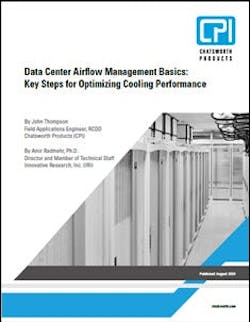One of the main operational challenges in data centers is optimizing cooling performance. Optimizing cooling performance improves capacity utilization and may allow cooling system adjustments that reduce cooling costs and OPEX. In air-cooled data centers, the key is to understand how changes in the site impact cooling, and how airflow management can be used as a tool for optimization.
There are practical limits to how much power or air can be delivered to a cabinet depending on each room design. However, today’s average cabinet density of 8-10 kW is well within the cooling capacity of typical airflow supplied to the cabinet. With this in mind, it is likely many organizations still have some unused or possibly wasted cooling capacity in their air-cooled data center, especially if they do not practice a comprehensive airflow management strategy.
This white paper, by Chatsworth Products (CPI) and Innovative Research Inc. (IRI), provides an overview of the key steps for optimizing the cooling performance of air-cooled data centers. This includes employing a Computational Fluid Dynamics (CFD) modeling software tool for analysis and exercising airflow management best practices that will help data center managers understand the what and how of optimizing airflow and, consequently, cooling performance.
